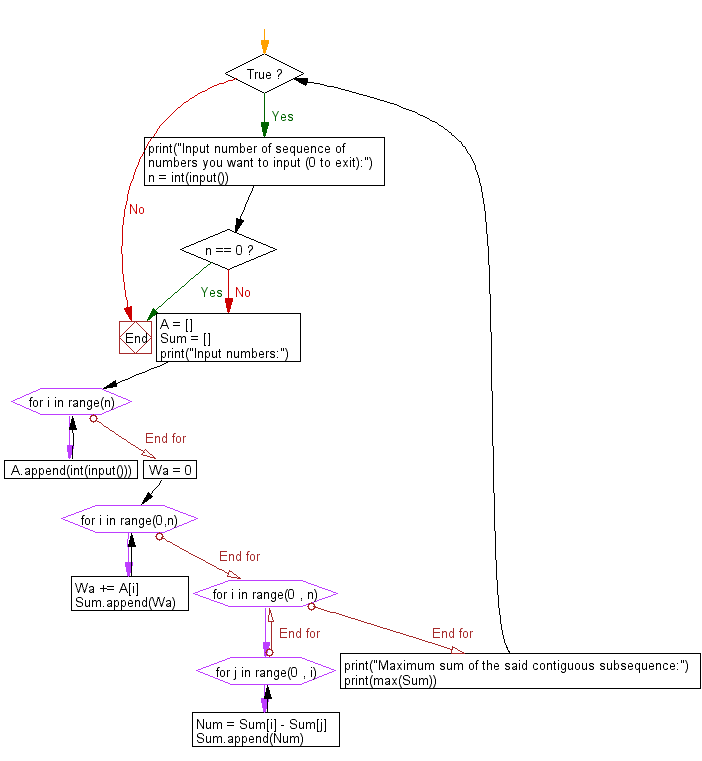Python: Find the maximum sum of a contiguous subsequence from a given sequence of numbers a1, a2, a3, ... an
Max Subsequence Sum
Write a Python program to find the maximum sum of a contiguous subsequence from a given sequence of numbers a1, a2, a3, ... an. A subsequence of one element is also a continuous subsequence.
Input:
You can assume that 1 ≤ n ≤ 5000 and -100000 ≤ ai ≤ 100000.
Input numbers are separated by a space.
Input 0 to exit.
Input number of sequence of numbers you want to input (0 to exit): 3
Input numbers:
2
4
6
Maximum sum of the said contiguous subsequence:
12 Input number of sequence of numbers you want to input (0 to exit): 0
Sample Solution:
Python Code:
# Infinite loop to continuously receive input until the user enters 0
while True:
# Prompt the user to input the number of sequence of numbers (0 to exit)
print("Input number of sequence of numbers you want to input (0 to exit):")
# Take user input for the number of sequences
n = int(input())
# Break the loop if the user enters 0
if n == 0:
break
else:
# Initialize empty lists A and Sum to store input numbers and cumulative sums
A = []
Sum = []
# Prompt the user to input numbers for the sequence
print("Input numbers:")
# Take user input for the sequence of numbers
for i in range(n):
A.append(int(input()))
# Calculate the cumulative sum of the sequence
Wa = 0
for i in range(0, n):
Wa += A[i]
Sum.append(Wa)
# Generate all possible contiguous subsequences and add them to the Sum list
for i in range(0, n):
for j in range(0, i):
Num = Sum[i] - Sum[j]
Sum.append(Num)
# Print the maximum sum of the contiguous subsequence
print("Maximum sum of the said contiguous subsequence:")
print(max(Sum))
Sample Output:
Input number of sequence of numbers you want to input (0 to exit): 3 Input numbers: 2 4 6 Maximum sum of the said contiguous subsequence: 12 Input number of sequence of numbers you want to input (0 to exit): 0
Explanation:
Here is a breakdown of the above Python code:
- First the code uses an infinite while loop to repeatedly receive input until the user enters 0.
- It prompts the user to input the number of sequences and breaks the loop if the input is 0.
- Inside the loop, it initializes empty lists A and Sum to store input numbers and cumulative sums.
- It prompts the user to input numbers for the sequence and calculates the cumulative sum (Sum).
- The code generates all possible contiguous subsequences and adds them to the Sum list.
- It prints the maximum sum of the contiguous subsequence using the max function on the Sum list.
Flowchart:

For more Practice: Solve these Related Problems:
- Write a Python program to find the contiguous subsequence within a sequence that has the maximum product.
- Write a Python program to identify the contiguous subsequence with the minimum sum in a list of numbers.
- Write a Python program to determine the maximum sum of a contiguous subsequence in a circular array.
- Write a Python program to find the sum of the longest increasing contiguous subsequence within a sequence.
Go to:
Previous:Write a Python program to test whether two lines PQ and RS are parallel. The four points are P(x1, y1), Q(x2, y2), R(x3, y3), S(x4, y4).
Next: Write a python program to test if circumference of two circles intersect or overlap.
Python Code Editor:
Have another way to solve this solution? Contribute your code (and comments) through Disqus.
What is the difficulty level of this exercise?
Test your Programming skills with w3resource's quiz.
